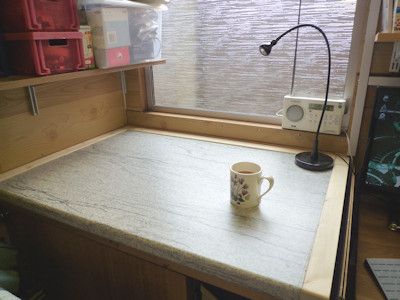Not so sure about kitchen worktop as a benchtop. Its very smooth and slippy for easy cleaning so stuff tends to roll off. Not helped by the nicely curved edge. Generally the top surface is quite easily damaged too. I've always found it unpleasant to work on when doing mechanical or other workshop type jobs.
The labs I worked in at RARDE / DERA / DRA had heavyweight lino tops on teak(?) support structure with poper, carpentry made cupboards beneath. DRA management decreed modernisation pulled the whole lot out to replace with cheap metal frames and legs, smooth melamine tops and kitchen cabinet style cupboards. Total and utter crap. Much less pleasant to work on. Pretty much a riot from the worker bees once we realised what was going on. Management got bonuses for spending a fortune making things worse.
Heavyweight lino and a suitable under support is probably too expensive for normal folk. Especially as it needs a nice battening around the outside edge.
Consider a moisture resistant T&G flooring board with the slightly rough surface, such as Cabertek P5 (but do look before you buy), as an alternative. Not silly expensive, so binning if damaged doesn't hurt too much. The rough surface stops things rolling too far but isn't so rough as to be damagingly abrasive. I usually pin a softwood batten on the edge with a tiny bit of upstand over the surface to further help control rollers. Perhaps 1/2 mm or a bit more so no great impediment to sliding heavy stuff off.
Great for shelves too, with a bit more upstand on the edge batten, 1/16 or so, on high ones! Upstand is a bit annoying on high ones 'cos I have to get the fold up step stand out rather than drag stuff off at head and above height. Enforced safety is probably a good thing as drag off has come close to being more than a bit risky in the past.
Clive
Chris Mate.





